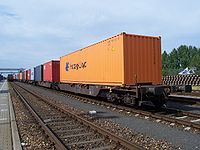AY Honors/Model Railroad/Answer Key
1. Give the history and development of model railroading.
2. Tell the difference in how the following prototype motive power units operate:
a. Steam
b. Diesel
c. Electric
3. Know the name, scale, and track gauge for four model railroad gauges.
The six most popular scales used are: G scale, Gauge 1, O scale, H0 scale (in Britain, the similarly sized 00 is used), TT scale, and N scale (1:160), although there is growing interest in Z scale. H0 scale is the single most popular scale of model railroad. Popular narrow-gauge scales include HOn3 Scale and Nn3, which are the same scale as HO and N, except with a narrower spacing between the tracks (in these examples, a scale three feet instead of the 4'8.5" standard gauge).
The words scale and gauge seem at first to be used interchangeably in model railways, but their meanings are different. Scale is the model's measurement as a proportion to the original, while gauge is the measurement between the two running rails of the track.
| Name | Scale | Gauge |
|---|---|---|
| G scale | 1:22.5 | 45 mm |
| Gauge 1 | 1:32 | 44.45 mm |
| 0 scale | 1:43 or 1:48 | 32 mm |
| H0 scale | 1:87 | 16.5 mm |
| TT scale | 1:120 | 12 mm |
| N scale | 1:148 to 1:160 | 9 mm |
| Z scale | 1:220 | 6.5 mm |
4. Know the shapes and names of at least eight track plan arrangements.
5. Know at least six points to check for the maintenance of a model railroading layout.
6. Identify and explain the use of:
a. Five types of freight cars
Covered Hopper
Structurally, a covered hopper is very similar to an opentop hopper car. What distinguishes this type of car from an open hopper is the car's roof, and also the car's overall size. Covered hoppers typically carry loads of less dense, and therefore lighter, materials, so they are built to a higher cubic capacity than open top hoppers.
More Info:
- http://www.uprr.com/customers/equip-resources/cartypes/covered.shtml
- Wikipedia article on Covered hopper
Box Car
More Info:
Container Car
Gondola
Refrigerator Car
Stock Car
In railroad terminology, a stock car is a type of rolling stock used for carrying livestock (not carcasses) to market. A traditional stock car resembles a boxcar with slats missing in the car's side (and sometimes end) for the purpose of providing ventilation; stock cars can be single-level for large animals such as cattle or horses, or they can have two or three levels for smaller animals such as sheep, pigs, and poultry.

